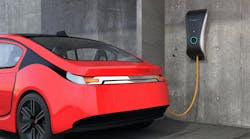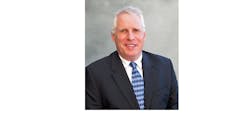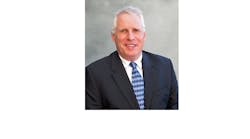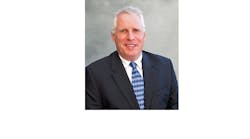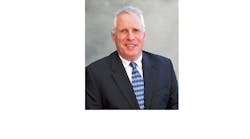In its early days, Electrical Wholesaling changed names about as many times as a teenager changes clothes on a given day.
The magazine first appeared in February 1920 as The Jobber's Salesman. In 1932, the name changed to Electrical Wholesaling. In 1938, the name became Wholesaler's Salesman. Finally, in 1946, the name changed back to Electrical Wholesaling, its proud name ever since.
Although Electrical Wholesaling altered its name a few times in the early years, its mission has been constant. For 85 years, the magazine has provided readers with the information and perspective needed to ensure success in the wholesale distribution of electrical equipment.
Flipping through 85 years' worth of magazine pages, Electrical Wholesaling's staff learned about more than just the electrical business. Over the years, the magazine's pages reflected the social, historical and technological context in which they were published.
Reading issues of The Jobber's Salesman from its first year in 1920, you quickly get a sense of the optimistic mood of the nation. With World War I finally over, the United States stood on the threshold of the Roaring 20s, an era of spectacular growth in part because the electrification of many U.S. regions was in full swing. It was a good time to be a distributor or manufacturer of electrical equipment.
Nevertheless, the social indifferences of the day were also painfully obvious in The Jobber's Salesman. Some of the magazine's articles contained offensive references to and line drawings of black people, and some advertisements illustrated women in questionable poses, or in subservient roles to men. But with time, comes change.
Among the many changes recounted through the years in the pages of Electrical Wholesaling, the march of technology is the most fascinating. The electrification of the United States, sale of radios and white goods, development of fluorescent lighting, and introduction of computers in business applications have all been key editorial themes over the years. The technology march continues still.
“As I have seen over the 60-some years that I've been in business, the changes that have come about — the improvements in the electrical lines — have been outstanding,” said Meta A. Griffith, the 95-year-old owner of Griffith Electric Supply, Trenton, N.J., in a recent interview with Electrical Wholesaling.
Meta Griffith and her husband, Bill Griffith, founded Griffith Electric Supply in 1938. In 1971, when Bill died, Meta took the company reins. Today, Meta Griffith is assisted by Griffith Electric President Bill Goodwin, but she remains the head of company's board.
“In this industry, the technology will continue to change,” said Griffith. “This is a very interesting business. There's a future in it.”
This 85-year retrospective explores some of the ideas, people and trends that made this industry tick. They will remain bricks of the industry's foundation for the future.
An Ode to SimplicityForget the Blackberries, two-way pagers, cell phones and fax machines. Before any of these tools existed, the electrical distribution business somehow got along just fine — and by some measures at higher gross margins. Alas, as you can see in this photo from the 1970s, computers were starting to become part of the business.
When White Goods Were Red HotCan you imagine competing with Best Buy or Sears for sales of refrigerators, cooking ranges, water heaters, washing machines and other household appliances? Large retailers eventually drove distributors away from this market, but it was big business in the electrical wholesaling industry. Until the early 1970s, electrical distributors sold “white goods” such as toasters, vacuum cleaners, waffle irons, clocks, Christmas tree lighting and toy train sets to Main Street stores, which were then called “dealers.”
The holiday season was a particularly busy time of year. In the December 1938 article “Mopping up on Christmas sales,” the author urged readers to focus on a last-minute advertising blitz:
“Now is the time for dealers to put on extra advertising splash. Be sure they have mats and layouts for newspaper ads! And plenty of literature on every appliance! And kids out peddling Christmas atmosphere handbills! Also — are displays changed frequently enough? Are they putting on a phone program to remind the neighborhood that electrical appliances make ideal Christmas gifts?”
A Note from the MasterTom Preston, the magazine's editorial director from 1988 to 1991 and a junior editor for the magazine in the 1950s, could really turn a phrase. His prose was unmistakable. It flowed through the pages of Electrical Wholesaling, the two magazines he launched (TED and Lighting Spectrum), the promotions he did for the National Electrical Manufacturers Representatives Association as one of the founding fathers, the retirement speeches he wrote for many industry colleagues, and in the simple typewritten notes he sent to friends and business associates throughout the electrical industry.
If you ever received a note from Tom Preston, you probably kept it to this day. It most likely contained a morale-boosting “thank you,” a gentile but well-crafted jab that made you laugh out loud, or a personal challenge for you to strive to attain some perceived greatness he saw in you.
His words came from the heart of a born writer who probably could have written novels, screenplays or Irish dramas, if he had chosen those venues. Fortunately for the electrical business, he chose this industry.
The Merchandising MavenIn the late 1980s and early 1990s, electrical distributors were desperate for ideas on how to win the battle against Home Depot in the aisles of their own counter areas. Ideal Industries' JoLynn Rogers was always there for them. She taught countless electrical distributors how to redesign counter areas and promote their companies more professionally by drawing from merchandising strategies from the retail world. Rogers did it all with the unforgettable energy of someone who truly loves what they do.
Positioning Rogers as an industry resource on merchandising was a brilliant move by Ideal Industries, and the company enjoyed not only the increased sales of its products through her merchandising strategies but also additional mind share with distributors because of Rogers' popularity.
Requests for Rogers' wildly popular series of merchandising articles that ran in EW during the early 1990s kept the magazine's editorial staff busy at the photocopier. She won a Ganzenmuller Electrical Marketing (GEM) Rising Star Award in 1997 from EW for her contributions to the industry.
Big Bucks Even in Those DaysElectrical Wholesaling has always provided readers with sales data. This graphic from the May 1941 issue painted a picture of the ebb and flow of industry sales from 1916 to 1940.
A 1920 issue of The Jobber's Salesman looked closely at product segment sales forecasts, offering these estimates for 1920:
Home Depot and other home centers get lots of credit for being master merchandisers, but other savvy salespeople had plenty of good merchandising ideas years before Home Depot got its first coat of orange paint. EW's editors found this 1940 photograph of Jules Dreyfuss, a Florida manufacturers' rep, in the magazine's archives. Dreyfuss is standing next to a promotional display of electrical fittings. The photo is inscribed, “Dreyfuss' Silent Salesman.”
The War YearsThe magazine, then called Wholesaler's Salesman, reflected the patriotic mood of the country during World War II. The covers, articles and ads published during the war years often played up patriotic themes, saluting the troops overseas and the workers back home in armament plants. For electrical distributors, their customers and electrical manufacturers, the huge ramp-up in the construction of industrial plants necessary to feed supplies to the armed forces meant big business. The lighting market grew by leaps and bounds during these years, in part because of how few factories were lit before World War II, as well as the development of fluorescent lamps a few years earlier.
Lots of Laughs for a Good CauseIt's amazing what a group of people can do for a good cause when they put their heads together. The Greater Chicago Area Electrical Industry Friends of Comic Relief, a group of distributors, reps and manufacturers from the Windy City, staged several memorable benefits for the homeless during the 1990s. Shelley Long of Cheers fame; the actor Sinbad; comedians Caroline Rhea and Louie Anderson; and rock legends Crosby, Stills and Nash were just a few of the entertainers who headlined the events.
The Diy Market: A Monumental ConcernElectrical distributors used to be terrified home centers would put them out of business. Through the 1980s and into the mid 1990s, EW's pages were filled with articles about how to effectively compete with what was then called the do-it-yourself (DIY) market. Although Home Depot and Lowe's have torn away a big chunk of the electrical business for themselves, they haven't put any electrical distributors out of business. In fact, the smart distributors learned from these masters of merchandising and promotions, refining their own marketing strategies to grow and prosper.
The Sweet Smell of OpportunityAn early issue of The Jobbers' Salesman urged readers to take advantage of what today seems like virtually unlimited opportunities for the sales of electrical supplies. In 1920, half the homes in the United States were without electricity. Said one article, “There are approximately 24.4 million homes in the United States. Of these, 9.2 million are lighted by electricity and 15.2 million are without electrical service…. What a market for the progressive contractor for Mazda Lamps, sockets, wiring conduit, safety switches, inclosed cutout boxes, etc.!”
Hammering out Allen-bradley's Distributor PolicyLes Watson was hired by Allen-Bradley in 1948 to put together the company's first distribution policy. Up to that time, almost all Allen-Bradley motor controls were sold direct.
Old-timers in the business who either worked for Allen-Bradley or sold the company's products as a distributor always have plenty of Les Watson stories. He was a tough character, but he was highly respected by Allen-Bradley distributors because of how he looked out for their best interests at the company's Milwaukee headquarters.
In the 20 years Watson worked for Allen-Bradley, the company's percentage of sales through distributors grew from 13 percent to more than 80 percent. Many of the distributors he enlisted are still Allen-Bradley/Rockwell Automation distributors today.
A Towering IntellectAt well over 6-feet tall, George Ganzenmuller, Electrical Wholesaling's chief editor from 1955 to 1986, always stood out at industry gatherings. But when you got to know George, it wasn't his physical size that really made an impression; it was the depth of his understanding of the electrical wholesaling industry, his total honesty and the respect he held from the captains of the electrical industry.
Andrea Herbert, his successor as EW chief editor, said Ganzenmuller was like a magnet at industry meetings, constantly attracting the industry's top executives for a few moments of quiet conversation about the issues of the day.
George was a quiet man by nature who enjoyed reflecting on the industry's concerns, spending time with his family and fishing the lakes, streams and ocean near his New Jersey home and in New England. Ganzenmuller didn't care to draw attention to himself, but he wasn't afraid to take a stand on complex issues in his monthly “Times and Trends” editorial. He didn't think buying/marketing groups were good for the electrical industry, and he wasn't afraid to say so in his monthly editorial, always written on a manual typewriter.
He was a humble man with simple tastes who gave freely of his time and knowledge to other editors on the magazine's staff. For many years he enjoyed a daily lunch in McGraw-Hill's cafeteria with Andrea Herbert to discuss industry issues, part of his grooming process for the day in 1986 when she would succeed him.
Westinghouse: The Name Lives onIt had to be one of the electrical industry's gutsiest marketing moves. Your business proudly carries the family name for over 50 years. But a brand name with more than 100 years of solid equity in the lighting market is available. What do you do?
If you are Angelo Brothers, the family-owned, Philadelphia-based lamp manufacturer, you buy the use of that brand name for your business, pull the family name off of your headquarters, and replace it with the famed “Circle W” of Westinghouse Electric.
Westinghouse, with roots reaching back over 100 years to George Westinghouse and the earliest days of electrical business, is now owned by Viacom, which also licenses the Westinghouse brand to manufacturers that produce small kitchen appliances, vacuum cleaners, garage door openers, wireless intercom systems, and several other products.
Westinghouse isn't new to the lighting market. The company's lighting ads appeared in The Jobber's Salesman and Electrical Wholesaling for decades. In 1983, Westinghouse sold its lamp business to Royal Philips NV, which now operates the business as Philips Lighting Co., Somerset, N.J. The Westinghouse name never died. Two decades after the sale, the Westinghouse brand was still being mentioned as a preferred brand in the Brand Preference Study conducted by Electrical Construction and Maintenance (EC&M) magazine.
Although it was one of the biggest decisions in the history of Angelo Brothers, now Westinghouse Lighting Corp., Stan Angelo, the company's chairman says, “It wasn't as tough as most people think. The brand has such enormous equity.”
Angelo and his family officially changed the name from Angelo Brothers Co. to Westinghouse Lighting Corp. in 2003. The company previously had a marketing agreement with Viacom to use the Westinghouse brand on light bulbs. Three years after inking that licensing agreement, the company's lamp sales had increased 22 percent.
A Texas LegendWarren Electric's J.R. Thompson was a tough businessman with a tart tongue and a heart of gold. One of the most respected and feared deal makers of his day, this larger-than-life Texan did business on a handshake, and could cut someone down with no more than an icy stare and a deafening silence. Thompson scared the hell out of many a rookie salesperson by placing his pearl-handled revolver on his desk before sales negotiation started.
At its peak, the Houston-based Warren Electric was a yardstick by which many other distributors measured their companies. Warren Electric carried an enormous amount of inventory in its Houston warehouse to serve accounts in the Gulf Coast industrial and petrochemical industries. Helicopters flew from the roof of its Houston headquarters to make emergency deliveries to customers on offshore drilling rigs.
The money Thompson made riding the booms and busts of the Gulf coast petrochemical market is legendary. When he died in 1989, Warren Electric's sales topped $120 million. According to a 1995 cover story in Electrical Wholesaling, in the mid-1990s Warren Electric carried $14 million in inventory at its Houston headquarters, and a combined total of $25 million in inventory for all locations. Still, after Thompson's death, Warren Electric suffered through a bitter dispute over control of the company. Its financial problems forced his heirs to break up the company and sell its operations to Summit Electric Supply, Albuquerque, N.M.; and The Reynolds Co., Dallas, in 2002. Despite Warren Electric's troubles in its latter years, the legend of J.R. Thompson lives on.
Early Pioneers in Bar CodingIn the 1980s, most electrical distributors didn't think seriously about investing in bar coding. But in 1986 Marc Lessans (left) and Roy Beard of Commerce Electric Supply, Linthicum, Md., developed a bar coding system that cut their annual physical inventory count from three weeks to three days. They were years ahead of their time.
Same old Song“The credit man sits calmly at his desk and rejects new accounts that you have struggled hard to land. Every salesman knows that there should be much closer cooperation between the sales and credit departments.”
— First issue of The Jobber's Salesman
John J. McCarthy's sales instructions graced the pages of Electrical Wholesaling for more than 30 years, imparting timeless wisdom to distributor salespeople. For example, in the August 1966 issue, McCarthy offered sage advice for handling cold calls. Much of the advice still applies today.
Well before McCarthy joined the magazine in the '60s, Electrical Wholesaling doled advice to distributor sales forces. The May 1954 issue devoted much of its space to selling concerns, with articles titled “Just What Is Old-Fashioned Selling?” and “How One Distributor Is Selling Lots of Time Switches.”
Always all-out for all-phaseAlthough some people may have made more acquisitions than Ron Kinney, founder of All-Phase Electric Supply, Benton Harbor, Mich., no one else did it with as much flair. With his enormous energy and the marketing savvy of a Madison Avenue advertising executive, Kinney managed the growth of the company from its humble 1959 beginning in a converted A&P supermarket to its 1999 status as a super-regional distributor with more than 90 branches. All-Phase was acquired by CED, Westlake Village, Calif., in 1999.
Kinney did it all with unique style. His indoor swimming pool on the bluffs overlooking Lake Michigan included an enormous All-Phase logo set in tile. Kinney once hired a shoe-shine man for the All-Phase booth at an NAED regional, and with a bullhorn Kinney barked invitations for a shine to favored vendors who were passing by. And it's impossible to estimate how many pocketknives with the All-Phase logo he gave to industry associates.
Ron Kinney took enormous pride in the growth of his company, and was delighted with the February 1973 Electrical Wholesaling cover story that showed him surrounded by 14 telephones, one for each branch he owned at the time. Nine years later he was on the cover of EW again — with 62 telephones. He made the cover in 1989, too, but with 95 branches in 17 states at that time, we felt a similar cover shot with nearly 100 telephones would get a bit unwieldy.
Kinney is the only electrical distributor to make EW's cover three times.
Fluorescent LightingThe first practical fluorescent light was exhibited at the 1939 New York World's Fair. For years afterward, lamp manufacturers focused on promoting fluorescent lighting as an energy-efficient alternative to incandescent lamps. Nonetheless, lighting manufacturers were uncertain as to the future of fluorescent lamps and whether they would ever replace incandescent lighting.
According to sales estimates by General Electric and Sylvania Electrical Products, incandescent lamp sales hit $700 million in 1942, while fluorescent lamp sales would not break the $100-million barrier until 1945.
Paving the way for other Women in PublishingWhen Andrea Herbert came to Electrical Wholesaling in the 1970s, she started as an editorial assistant, basically a secretarial job at that time. Back then, many publishing executives thought that was the only editorial position for which women were qualified. Andrea proved them all wrong. George Ganzenmuller quickly saw her talent, and groomed her as his replacement.
Herbert built the magazine's ranking of the electrical industry's largest distributors into an industry resource and developed Electrical Wholesaling's widely respected Market Planning Guide. She was recognized by The American Business Press with its highest honor several times for the work she did on the Market Planning Guide. Many companies used the resource to set compensation plans, analyze new markets and discover their true market potential.
Herbert was a precisionist who always demanded the best of herself and her staff. The magazine's editorial dominance during her years as EW's chief editor speaks for itself.
A Plan for the AgesNestor MacDonald, Thomas &Betts' president and CEO for several decades during the 20th century, was a big believer in the distributor. He and his management team issued a public declaration of support in 1937 for T&B electrical distributors in “The T&B Plan.” That plan served as the model for future distribution policies of Thomas & Betts, as well as for the policies of other electrical manufacturers. It said:
“Forty years of experience have convinced us that wholesale distribution reduces the manufacturer's selling cost and thereby reduces the selling price of electrical supply material to the user. Therefore, our policy has been to distribute our products through the electrical wholesaler.
“We have now evolved a plan, the objective of which is to strengthen the T&B distributor's position with the users of electrical construction material, because anything we can do to help him, helps us.
“To accomplish the objective of this plan, we intend to advertise to the end user the value of the many services performed by the T&B distributor. Through trade papers and other media, we intend to broadcast our policies and demonstrate the underlying economic reasons for those policies.”
That concept of partnering still drives T&B's well-known Signature Service program. Electrical distributors that meet the requirements for participation in the Signature Service program receive marketing, merchandising, product training and many other services designed to help increase sales and profitability.
Running with Wlectrical WholesalingFor the industry's runners, joggers and walkers, many of the most memorable moments of NAED's annual meetings from 1985 to 2001 occurred during the Fun Runs sponsored by Electrical Wholesaling magazine. Dozens of runners and walkers of all ages and paces enjoyed some of the best running routes in North American cities, not to mention free commemorative T-shirts and after-race treats.
Those convention attendees who took part in the events will always remember the EW Runs fondly, from the first event along San Antonio's River Walk in 1985, to memorable races in Montreal; Chicago; Boston; Atlanta; Seattle; San Diego; Washington, D.C.; Orlando, Fla.; and Salt Lake City.
The best event was the unforgettable run across San Francisco's Golden Gate Bridge. It attracted more than 100 runners and walkers.
Tuning in Radio SalesDuring the 1920s, “The Jobber's Salesman” devoted many pages of editorial to the sales opportunities awaiting distributors in a new market: radio. A Chicago Majestic Electric Radio advertisement said, “Jobbers and dealers agree. The demand (for radios) grows and grows — and seemingly is endless.” The 1928 publication A Verified List of Electrical Jobbers (the predecessor of today's Directory of Electrical Wholesale Distributors) listed 650 “jobbers” selling radio equipment.
The Advantages of Advertising“Thousands of dollars are being spent each month by electrical manufacturers to reach the same fields that you cover. Are you working together?”
— P.A. Powers, identified in the February 1920 issue of The Jobber's Salesman as “one of the leading advertising executives in the industry.”
The February 1931 issue put electrical-material purchases by electrical contractors at $200 million. Electrical Wholesaling's 2005 Market Planning Guide estimates electrical contractors sales through full-line distributors at $35.76 billion this year.
Although Electrical Wholesaling's annual Market Planning Guide didn't emerge until 1979, the magazine has provided market sales and forecast data from the get-go.
